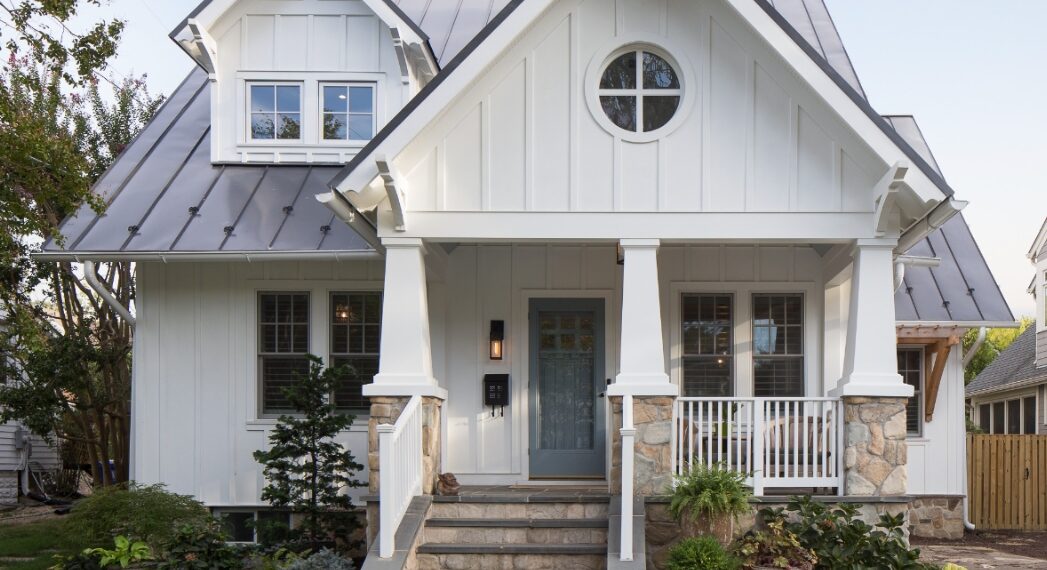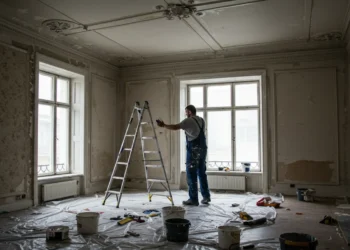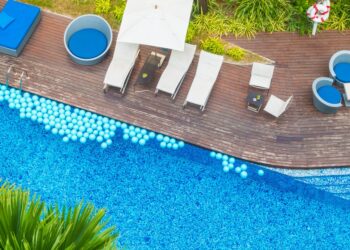Masonite siding is a powerful alternative to wood siding. It is synthetically constructed from a mixture of wood, fibers, wax, and various resins. All of these components are held together for the board. These are equally dense from all angles. It might look similar to a fiberboard which is generally used for kitchen cabinets.
Masonite Siding can resemble natural wood when painted into any color. Initially, it was sold as an alternative to wood siding.
It was initially introduced as an alternative to wood as it demanded lower maintenance and was cheaper. Masonite was their best middle path for the people who couldn’t afford wood but hated metal or vinyl siding. It is preferred by most people because of its strength and durability. Due to its strength, benefits eradicate the problems such as shrinking, swelling, or blistering, which we’re familiar with wood.
Types of Masonite Siding
The masonite siding can be availed in different types of finishes and looks. These different types are as follows:
- Shiplap Edge Panel Siding – It used shiplap joints on the long edges to be placed vertically.
- Lap Siding – It is the most common type of siding option available. There are horizontal boards that overlap the board beneath.
- Square Edge Siding – This type of siding is applied in sheets and vertically.
Some of the other variety of finishes include pre-primed, pre-stained, and pre-painted.
Uses of Masonite
Masonite being a synthetically made material having natural substances can be used in a variety of fields. Its strength, flexibility, and durability have helped it gain importance in my spheres. Some of the uses of Masonite are:
- Painting Support – Many artists use the Masonite as the support to their paintings. It is also used in an artistic media called linocut painting. This painting uses Masonite as a base, and the carving is done on it by the artist.
- Tables and ramps – The smooth surface of Masonite make it a better choice for the table tennis tables and skateboard ramps.
- Protection and movement – Masonite is many times used by moving companies. They primarily use it for the protection of the walls of buildings they carry out their work in.
Besides, Masonite is also laid on the floor for its smooth surface qualities. Those soft surfaces facilitate the rolling of heavy materials easily.
- Construction – Masonite is also used in the construction industry, mainly during the renovations when the floor gets completed firstly. The sheet of Masonite is used over the red rosin paper on the finished floor to keep them protected and safe while the other works are going on.
The duct tape is used to tape the masonite sheets together to prevent shifting. This process also helps in avoiding the leaking through the substances.
- Theatre Industry – The Masonite is widely used to construct theatre, films, and television. It is most prominently common in theatres as the stage floor appears matte black to us after it’s painted.
- Foot strips – The masonite panels are sometimes sawn into foot strips. These strips are later used to make the edge of sidewalks. They are used there because of the flexibility as curve shapes are required there while pouring concrete.
- Cake industry – The professional cake decorators use Masonite as the cake board extensively. Being a natural product, it is the most appropriate choice to hold something edible, such as cake.Besides, Masonite being a solid material, can easily support multi-story creations such as weddings or reception cakes.
- Music Industry – The masonite material is popular in the music industry too. It is said to be the best material to make a musical wobble board. As the musical wobble is often used as a canvas to cover it all with ornaments, Masonite proves to be the best support material.
Though not much popularly used, Masonite is also used in making the guitar bodies.
Advantages of Masonite Siding
Even though wood siding has been popular for a long time, masonite siding is undoubtedly a better replacement. The people have been choosing it for various reasons. Some of the most significant advantages of masonite siding are listed below:
1. Available in Diverse designs and sizes
Masonite siding, being manufactured synthetically, is available in various designs, sizes, and shades. Unlike the wood siding, there is no limitation on the size of masonite siding. Even the larger panels can be available to you at lower prices. A long range of finishes and looks are also available in masonite siding.
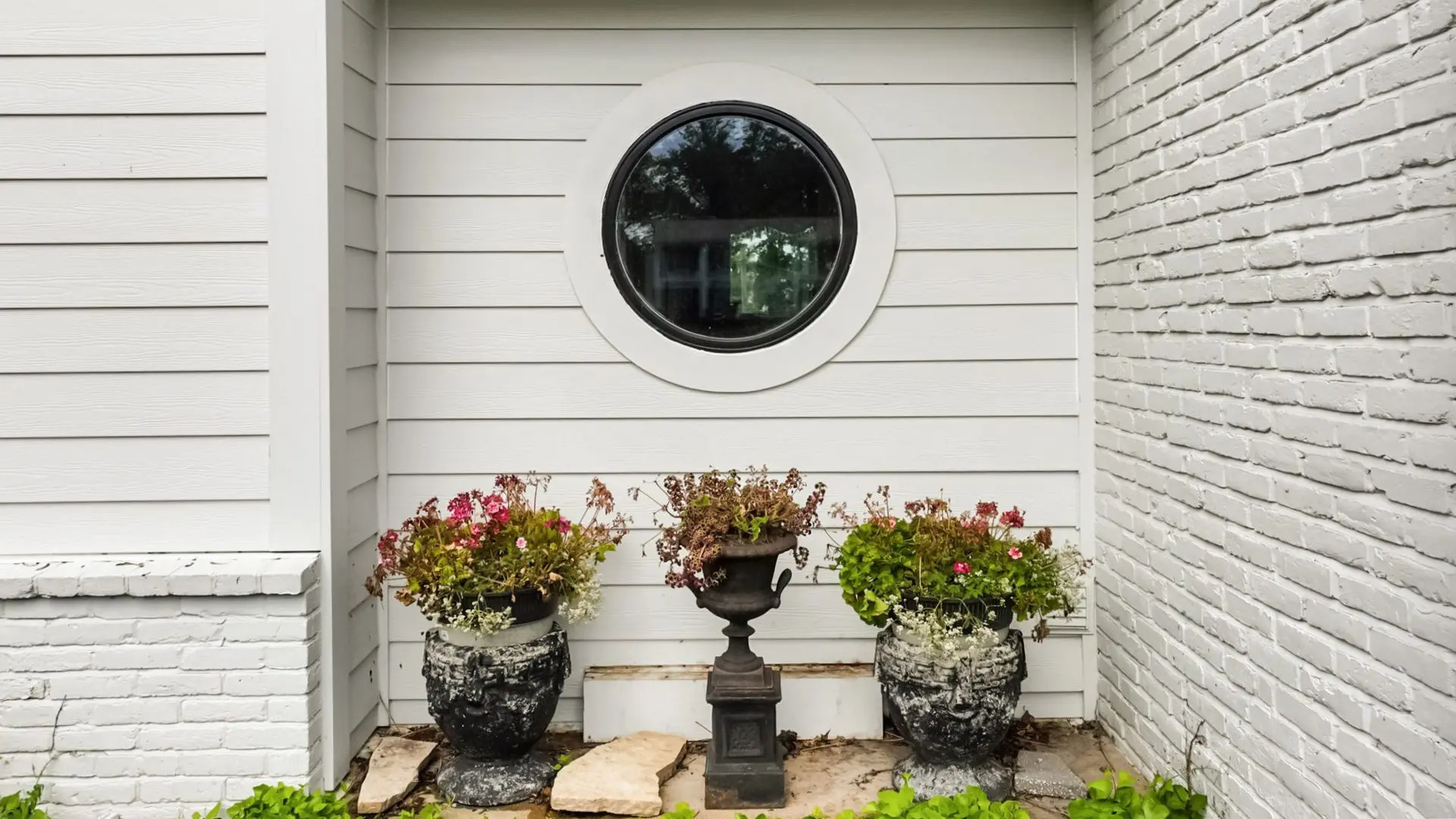
You can choose from pre-primed, pre-stained, and pre-painted finishes available. Personalized customization is also possible if you have purchased an unfinished masonite siding. You can paint or stain it as per your choice. This long range of variety isn’t offered in any siding type. The flexibility in the material and its use make it a better choice for people.
2. Environment Friendly
Unlike the other metal sidings and original wood siding, masonite siding is more environmentally friendly. Masonite Siding uses a mixture of wood, fibers, wax, and various resins, which are all-natural. When taken into comparison, the wood sidings are highly dependent on deforestation. The metal siding is not so environmentally friendly as they are dependent on the mining of natural resources.
Masonite doesn’t also use chemicals in the making, which can be harmful to the user or environment. Even when it is ultimately used and turned to waste, it can find its place in landfills. It has no harmful effects on soil on the water table. If you are a believer in sustainable development, then this siding is undoubtedly for you!
3. Affordable to all
The wood or metal sidings cost a lot without a guarantee of many benefits. The masonite siding provides you much more effective services at a cheaper rate. It cost only a fraction of the price of wood siding.
Besides being cheaper, masonite siding is cost-effective too. It can stand up to the changing weather conditions for many years as long as its protection layer stays intact. When you keep an eye on the maintenance and perform it periodically, the life of siding automatically increases. Hence, it is both cheaper and cost-effective.
4. Provides the Face of Real Wood
As the wood finish is the most admired and desired one in society, it doesn’t require wood siding to get that. The masonite siding can quickly provide you with a wood-like finish through paints and stains. It would take a very experienced person in materials to distinguish between the natural and Masonite wood look.
Even though vinyl or plastic can also provide similar looks, they are less attractive and more recognizable. You get masonite siding as the best deal at a lower price with more durability through all the seasons and years.
5. Easy to Install
The masonite siding is uniform in its density and weight. You can also avail of it in many sizes as per your requirement and desire. This advantage signifies a cheaper cost with your wish fulfilled.
As it is uniform and easy to carry, its installation is straightforward too. It would cost you only a little labor to have masonite siding installed. This would save you money too. Many house owners consider installing it on their own as the process isn’t very complex, and the installation procedures are readily available on the web.
6. Durability
As masonite material is flexible, the masonite siding is highly durable. Masonite doesn’t break or split during the installation, and the minor direct damages do not harm it. The masonite sidings are manufactured with a natural cement material which makes them durable.
The masonite sidings are installed in lap and vertical techniques, and they remain intact for almost 50 years.
You need to be careful about any cracks or openings at certain intervals and get them fixed immediately when found. Remember to replace any loose nail or missing sealant promptly. Just these few tips and your masonite sidings will serve you long enough.
7. Resistant to Rust
Being made from a natural material, it is evident that the masonite sidings are resistant to rust. Unlike those metal sidings, masonite sidings can live up to long years without getting exposed to rust.
Masonite sidings are also more resistant to temperature fluctuations, dents, and scratches. These features allow you to stay less worried about the sidings all the time. You’ll need to look out for them once in a while; otherwise, they’ll go on quickly.
Problems of Masonite Sidings:
Even after possessing so many advantages, Masonite developed some problems of its own. After a few years of its introduction into the market, the users identified the issues. These problems somehow led to a decline in its purchase too for some time. The commonly reported problems were :
1. Rotting
Buckling, swelling, and rotting are all common issues with masonite siding. The moisture infiltration causes this into the sidings due to various reasons such as cracks. The wood chips and resins cannot remain intact once they get wet. The water makes the wood swell, which causes the sidings to warp and buckle.
As the wood remains wet for a long time, it begins to rot, this makes the board decay, and it starts getting soft. The worst part is this cannot be repaired in any way. Rotting of siding directly means that you need to replace it.
2. Blistering
Another widespread issue with Masonite is Blistering. Even though Masonite requires less maintenance than wood, the paint is not a permanent finish. When this paint is exposed to moisture or heat, it starts to blister or bubble off. The blistering can also be caused by the insects eating through the siding.
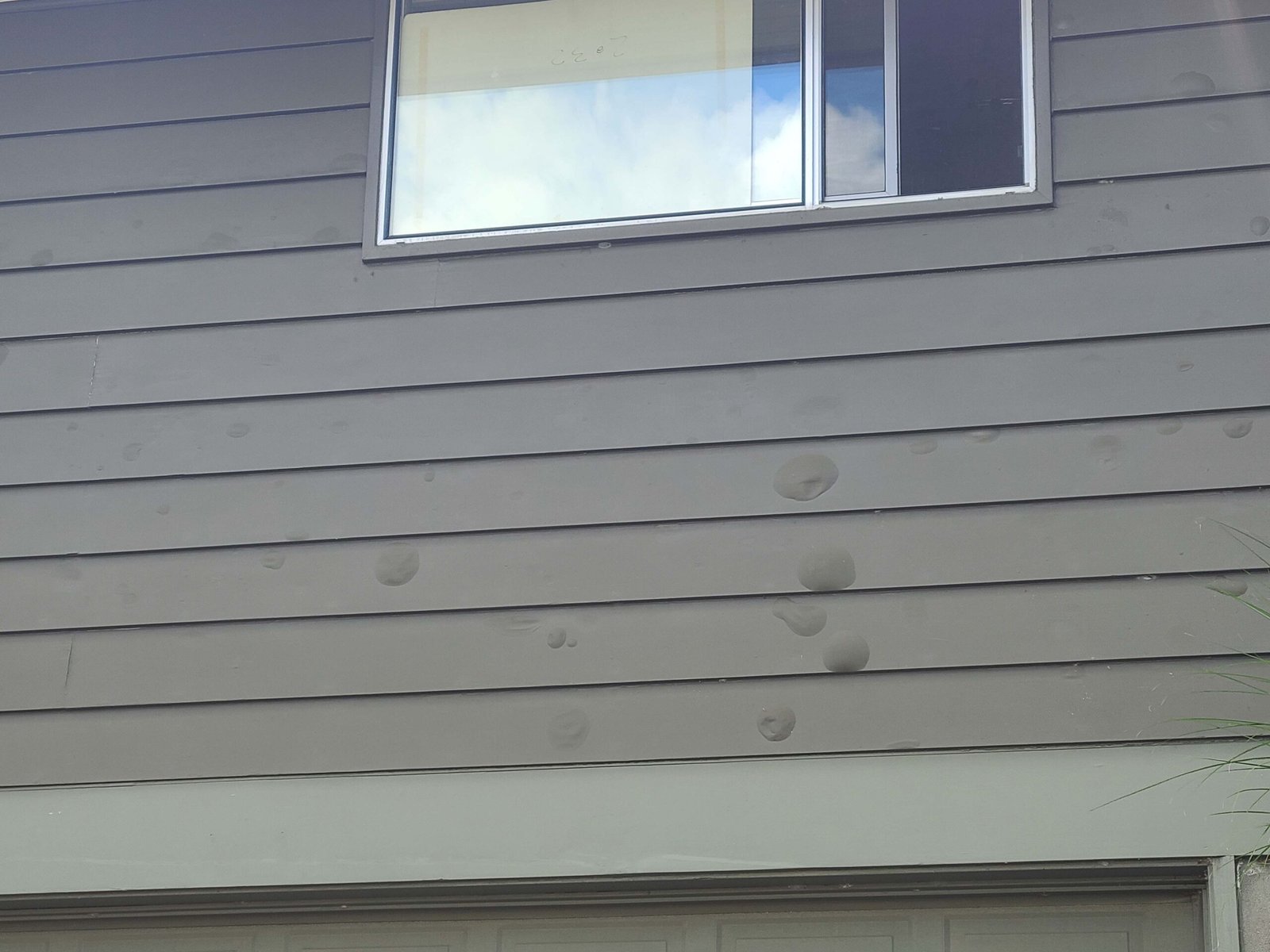
Due to this, the siding starts looking unattractive, but the moisture becomes more susceptible to reach beneath the paint. This directly leads to two losses together. To prevent this, the user will have to stay highly attentive to water coming in contact with siding in any way.
3. Mold and Mildew

When the moisture comes in contact with masonite sidings, it doesn’t come off quickly. It damages the sidings to the very core. The board starts getting damp, which becomes the perfect invitation to mold and mildew.
This problem might stay as low as leaving stains on the exterior of your house. This is not a minor problem because nobody wants an unattractive home when they have spent all of their income to build it. The worst that can happen is, the mold might start to grow deeper. This will infiltrate the whole interior of your house. Both the cases are alarming and problematic.
4. Insect Issues
Even though Masonite is not exactly a solid wood product, but it’s still made from wood. This makes it vulnerable to insect problems. Through the years, and due to exposure to moisture, the Masonite might begin to soften. This soft surface becomes attractive to some insects such as termites and carpenter ants.
These insects decay and compromise the integrity of the siding board. This is another non-repairable problem. You’ll eventually need to replace the siding.
5. Discoloration
Some users stay extra attentive towards the blisters and scraping. Even if you are one of them, you’ll not be able to prevent discoloration. It is something that is Masonite’s feature. Discoloration comes to it.
Hence, no matter how much you keep painting it, again and again, this will happen. Discoloration may be caused by resin or mold and mildew. Even if the paint is new, the stains will seep out of it.
How to fix the problems of Masonite Sidings?
There are problems with every material, but solutions and preventions can help you manage everything accordingly. The most common problem of Masonite as a material is that it is not very moisture friendly. Now, as it is vulnerable to moisture retention, some basic steps or decisions can be taken to repair it smoothly. These steps are :
1. Regular Examination
Masonite, even though having strength, durability and flexibility, is a very delicate material. It can bear many things, but moisture is like its weak point. Hence, it is essential to keep it under careful observation.
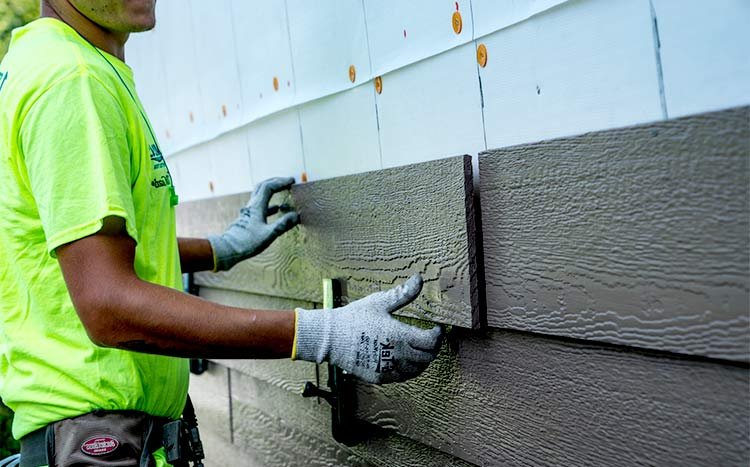
Though it is said to be a low maintenance material, the only thing it requires from you is its regular examination to prevent more enormous damages later.
2. Scrape off Paint
Always Remember to scrape off excess paint and debris using a paint scraper from the affected areas. The damaged areas should be scrub firmly, and you can scrub the soft spots with a wire brush.
This will help you to get rid of the loose fibers which have come undone. This helps in easy and quick maintenance of the material, making it last longer.
3. Elastomeric Compound
To seal the places from where you would have removed the rotten Masonite, use Elastomeric Compound. It will help to reduce further damages and keep the Masonite safe for some time.
You should keep reapplying the compound if any empty spaces are still left. This would lead to protection from moisture to the areas still better.
4. Get rid of cracks and holes
Cracks and holes are like the worst enemies of masonite siding. They are the real culprits which let the moisture in and lead to further long damages. Hence, it would be best if you always kept looking for the holes and cracks around it.
Permanently seal off the empty spaces like nail holes, joints, and seams. Such holes lead to most of the moisture interaction of Masonite. They should be sealed and repaired before they get much worse.
5. Use Putty
As crack and holes are the worst enemies, similarly, putty is like the best friend to Masonite. As putty is water-resistant, it can seal off the gaps and cracks of masonite sidings.
This would not only stop the current damages but will prevent long-term damages too. Sealing off these holes is the best way to take care of your masonite sidings.
6. Insect Repellants
As discussed before too, the soften and moisture-soaked Masonite attracts insects like termites. But besides attracting them, it becomes the ideal breeding place, too, leading to long-term damages.
These bugs and insects can live in Masonite, leading to the destruction of the foundation of your home. Use insect repellents to stop them from even approaching your masonite sidings. No insects mean no problems. Also, it is like a one-time investment to long-term benefits.
7. Repeat Coating
Whenever you feel it’s been a long since you monitored your masonite sidings and you want to do something creative, then paint the sidings. When you put an additional coat of paint over your last paint, it prevents damages to your sidings.
When a paint job is done very well, it can also close any cracks and gaps. Hence, a two-way benefit is obtained in a very artistic manner.
Conclusion
The masonite siding can be a good option when looking for reliable, attractive, and long-term sidings for your house. Before implementing anything in your home, it’s better to gain the correct information about it, including benefits and problems. You can analyze this information and make your decision accordingly.
Your house should be durable and attractive; everything else needs a little management. Everything can fall into place when you have the right tools and knowledge about something. Masonite Siding can be a fantastic option to add to the beauty of your house!
